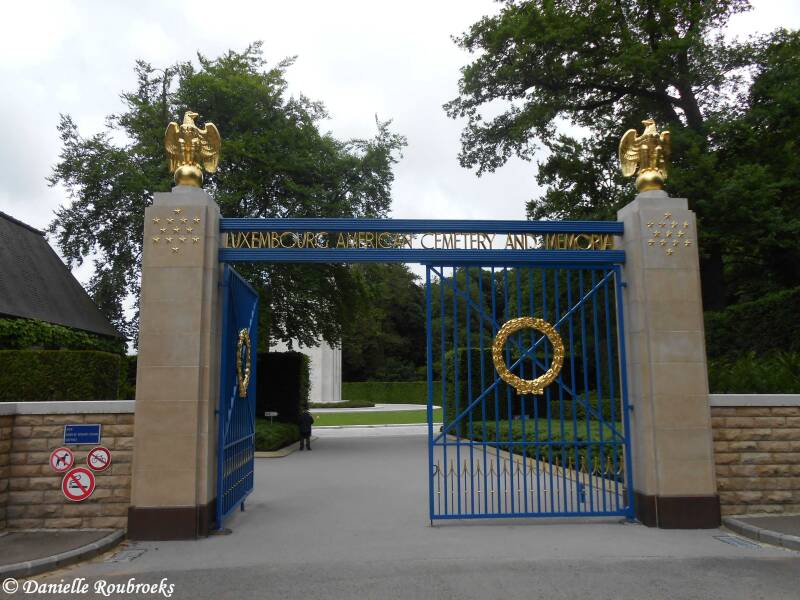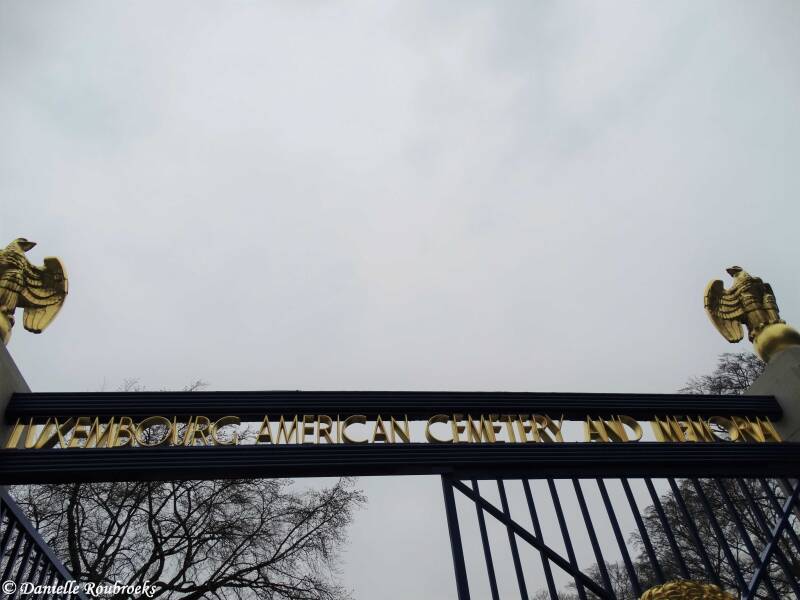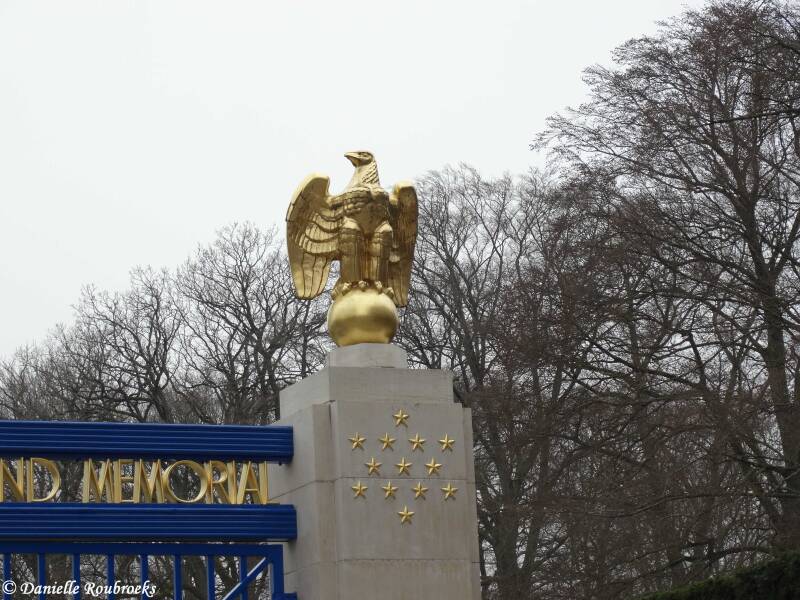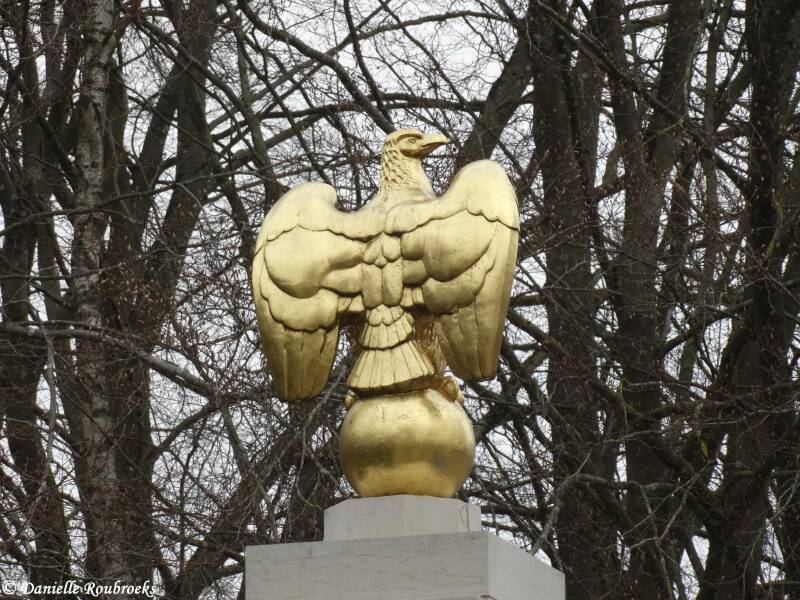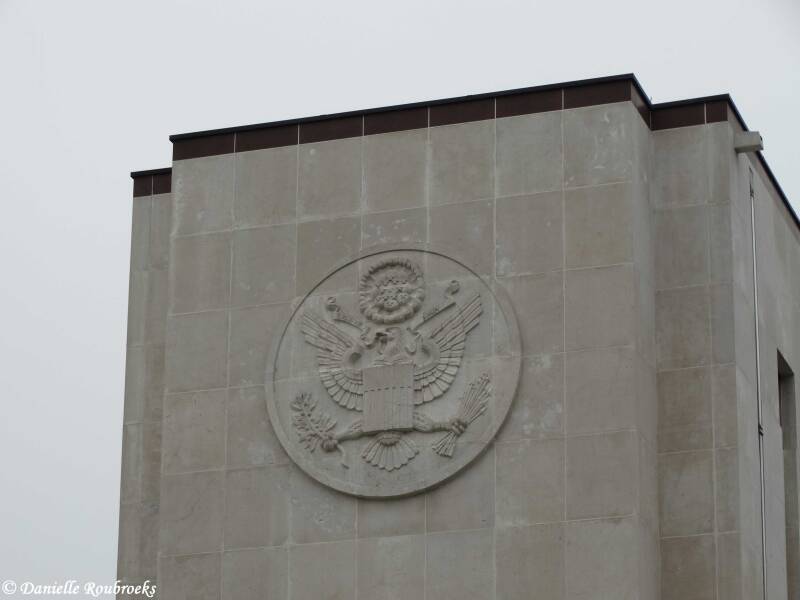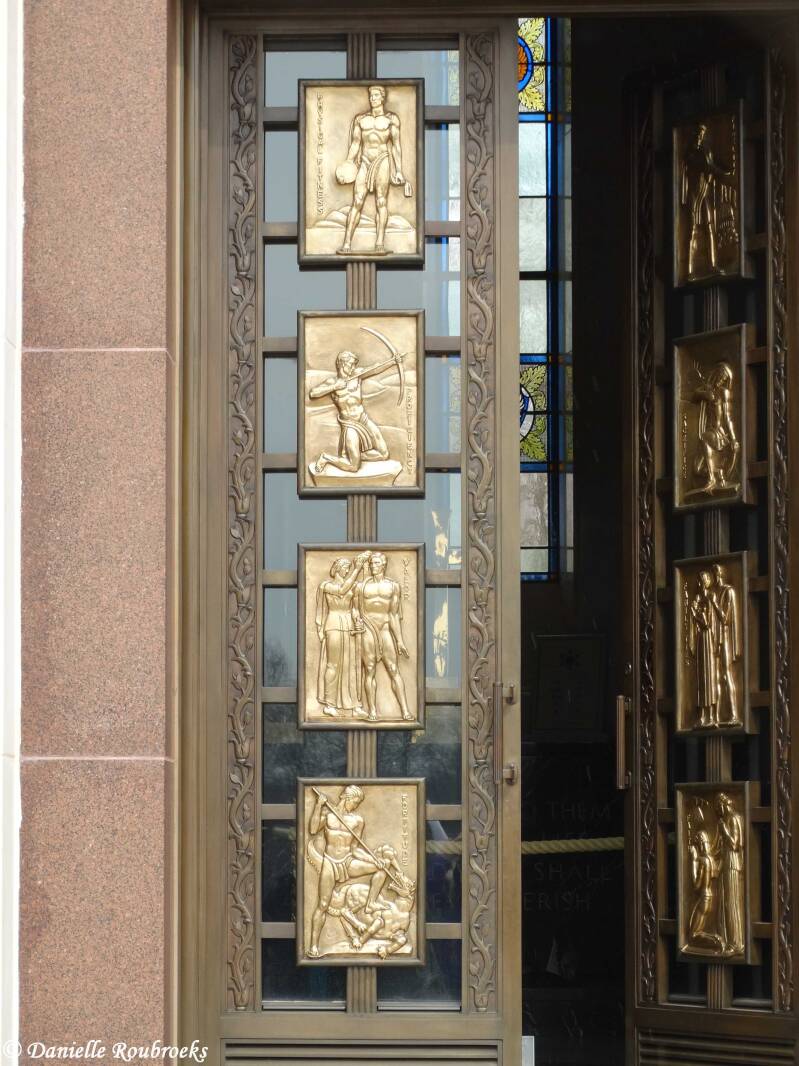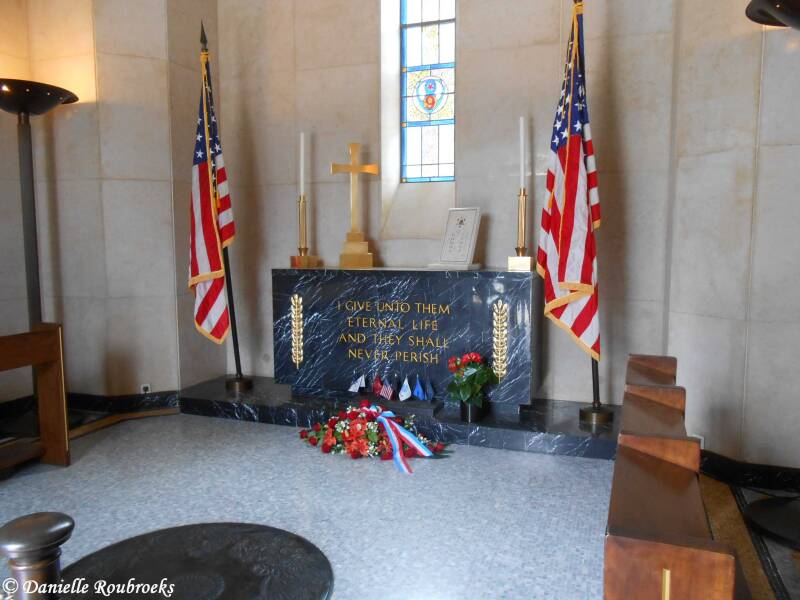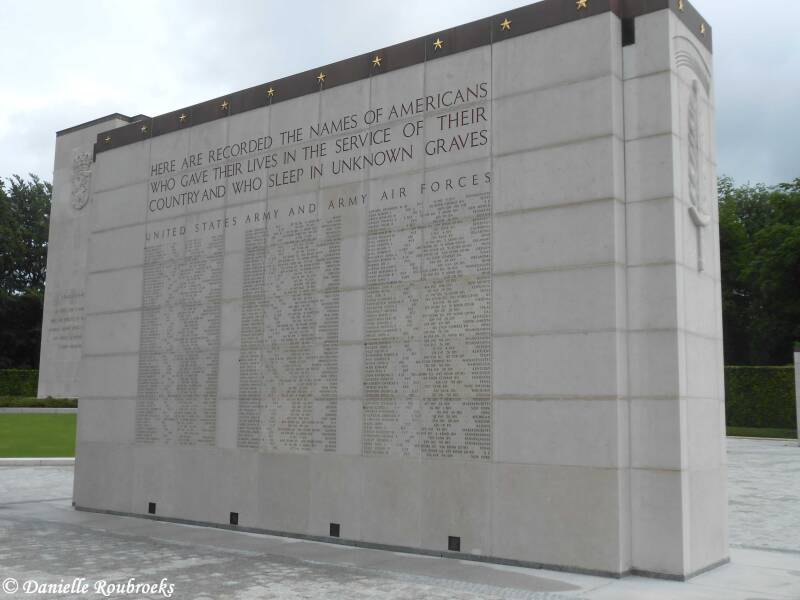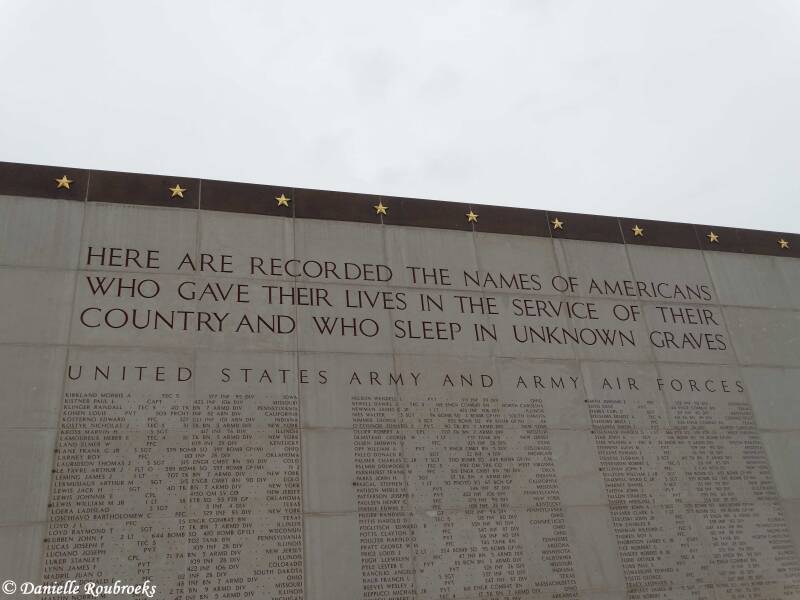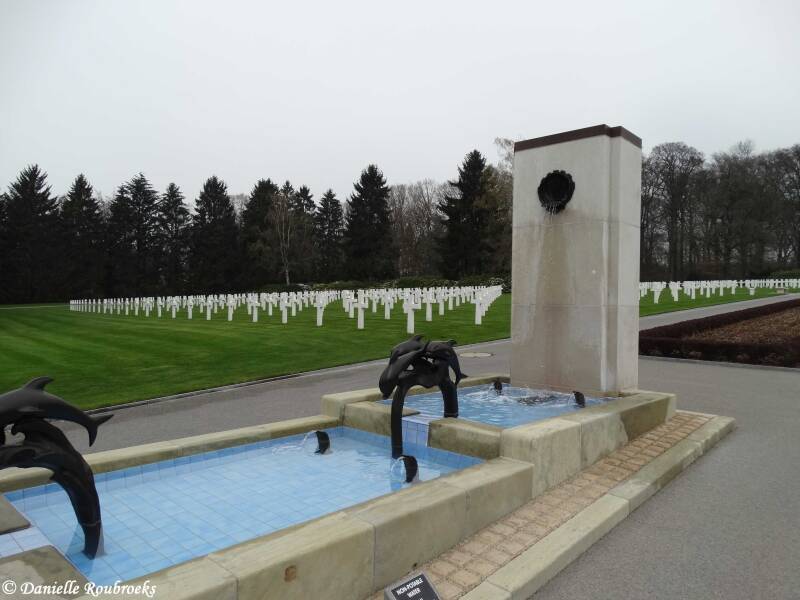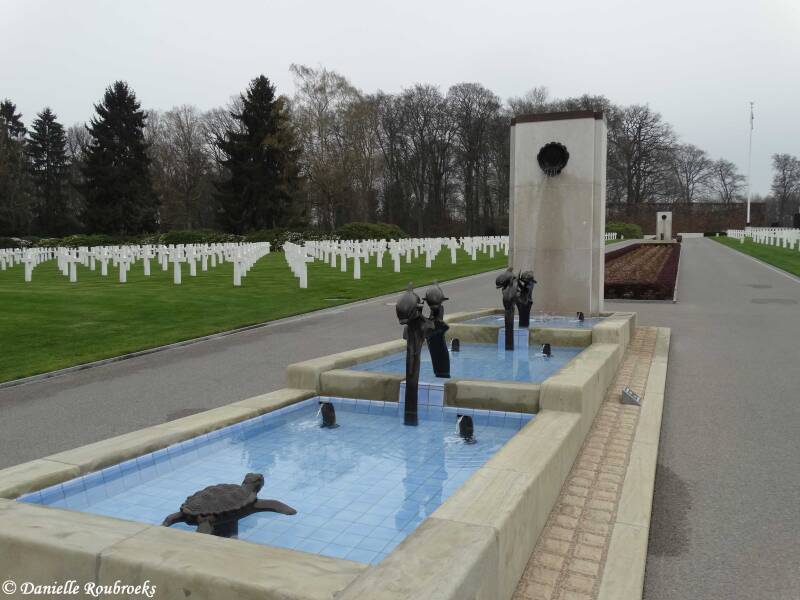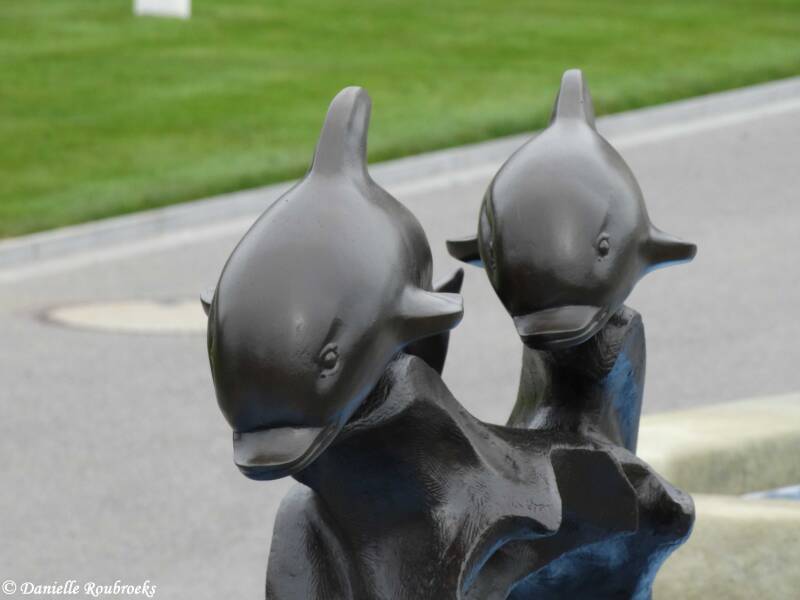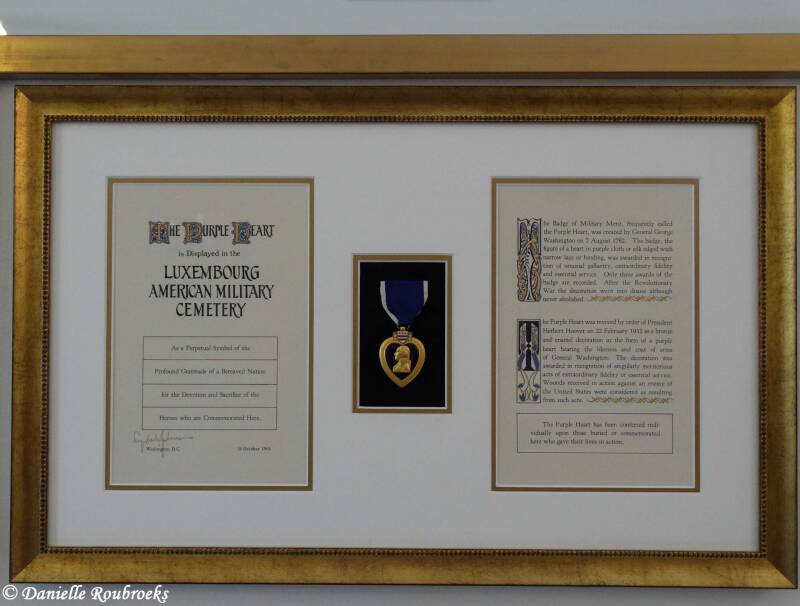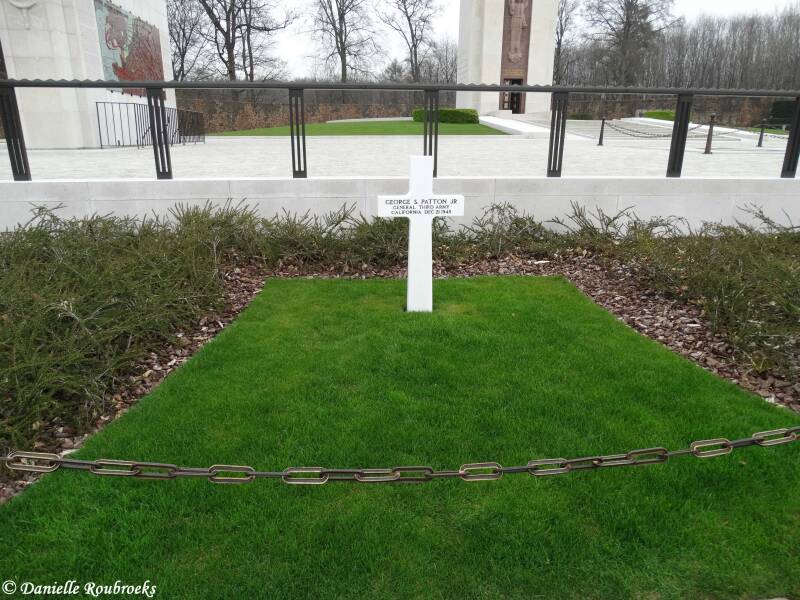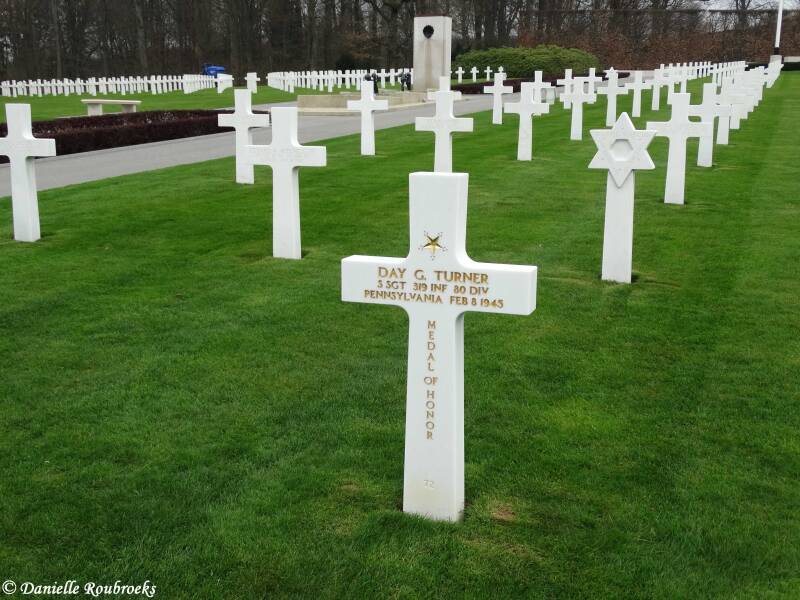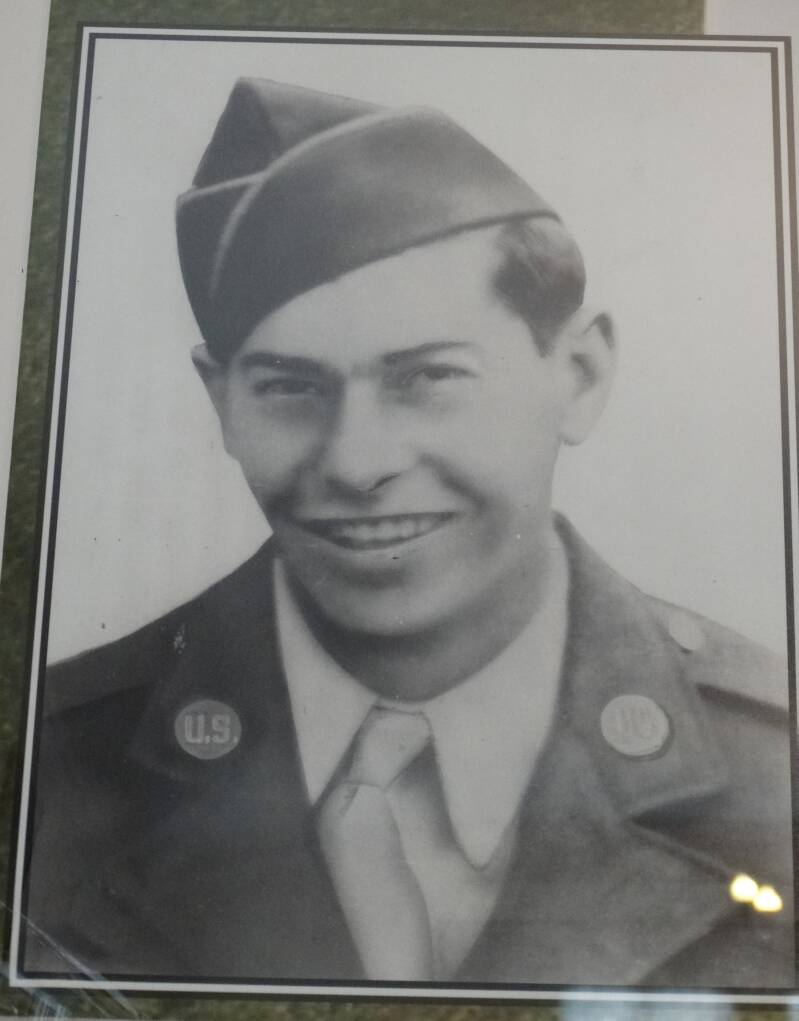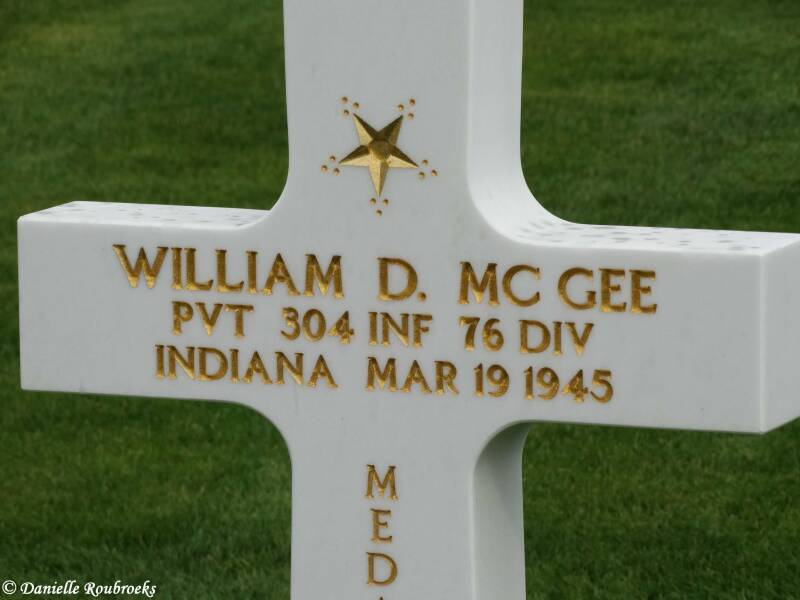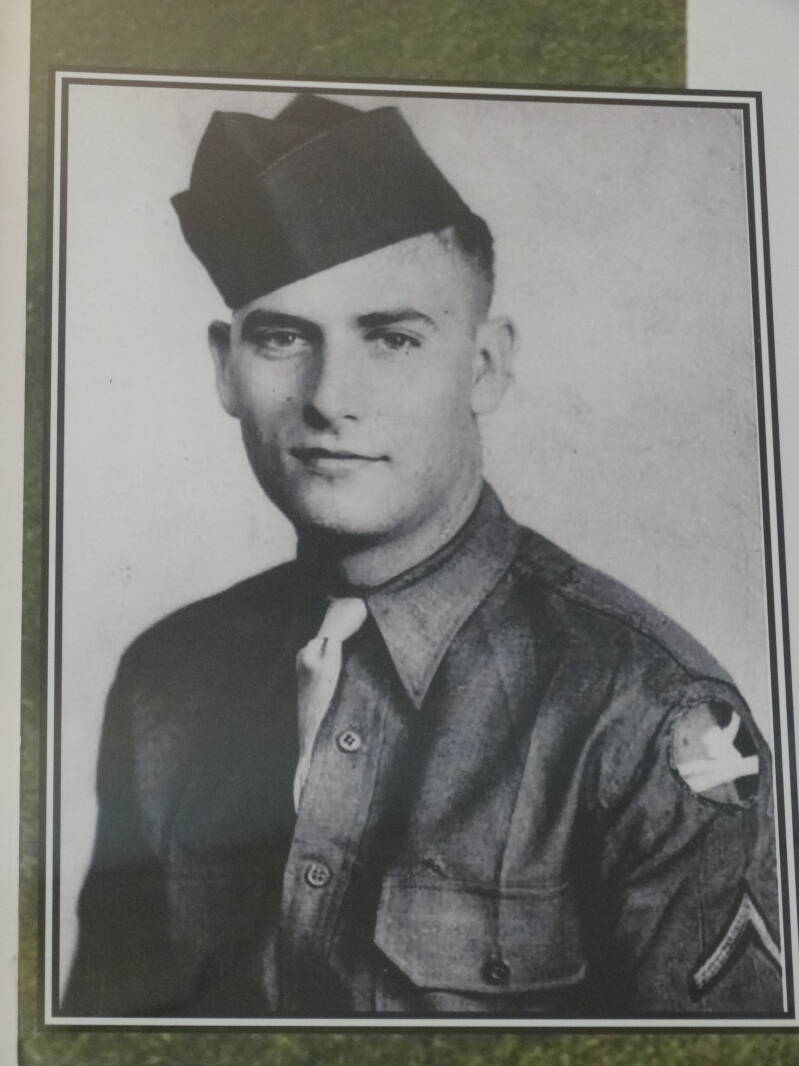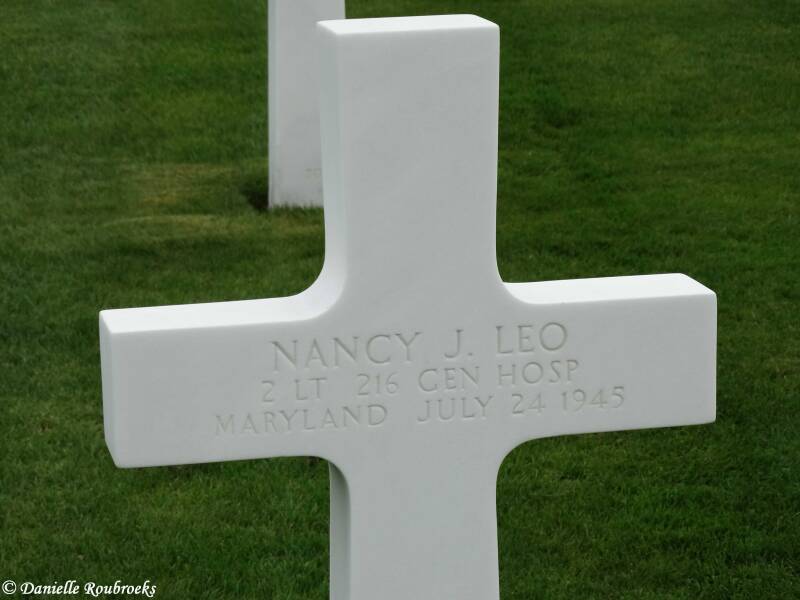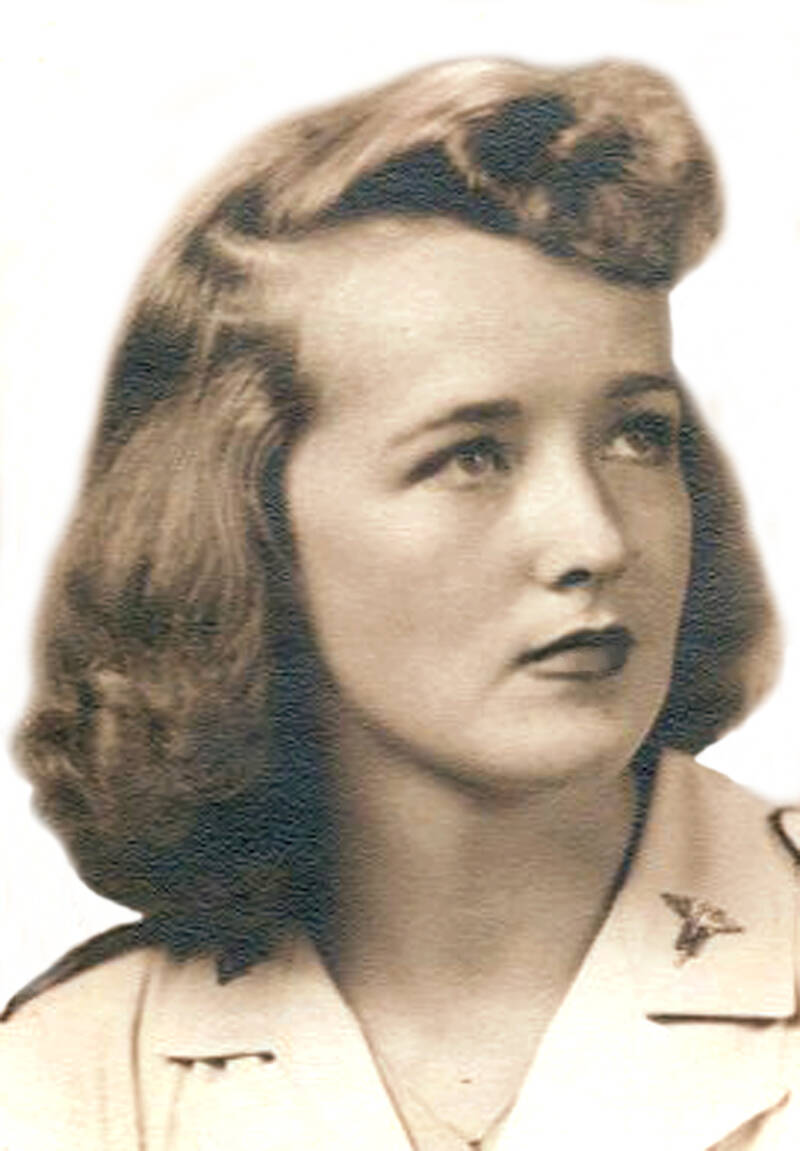Luxemburg American Cemetery
Historical Information (source: ABMC)
The cemetery consists of 17 acres of manicured lawn surrounded by 33.5 acres of woods. Entering through the gates, the visitor will see the impressive memorial chapel encompassed by a stone terrace directly in front of them. The chapel includes massive bronze doors embellished with gold leaf cartouches depicting military “virtues”, a sparkling mosaic ceiling and a colorful stained glass window showcasing the Army insignias representing the men and woman that rest in the cemetery. On the lower level of the terrace, two pylons face each other across a quote by Eisenhower about the sacrifice of military members. The pylons display the battle movements in the western European Operations (on the right) and those related to the Battle of the Bulge (on the left). On the reverse of the maps, 371 names of those missing in action are inscribed. Nineteen bronze rosettes identify men who have been recovered since the inscriptions were made and now rest in known graves. The visitor center, where information and brochures are attainable, is to the left as the visitor enters the front gates.
Sloping away from the terrace is the cemetery where 5,073 service members lie, many of whom lost their lives in the Battle of the Bulge and in the advance to the Rhine River. The design is a softly curving fan shape consisting of nine sections interspersed with four fountains, majestic trees, and expansive rose and rhododendron beds. It is a befittingly tranquil final resting place for these Americans who gave their all.
The cemetery was established on December 29, 1944 by the 609th Quartermaster Company of the U.S. Third Army while Allied Forces were stemming the enemy's desperate Ardennes Offensive, one of the critical battles of World War II. The city of Luxembourg served as headquarters for Gen. George S. Patton's U.S. Third Army. General Patton himself was buried here on Christmas Eve 1945, three days after he died in Heidelberg. His original grave was is an area now designated as Plot F and was moved to the top of the burial plots in 1947.
Among those buried here, there are 118 soldiers of the Jewish faith, whose headstones are in the shape of a Star of David, 22 pairs of brothers and one pair of close friends buried side by side at the request of their families, and one woman, an Army nurse.
Burials: 5.076 Missing in Acttion: 371
George Smith Patton Jr. (November 11, 1885 – December 21, 1945) was a General of the United States Army who commanded the U.S. Seventh Army in the Mediterranean theater of World War II, and the U.S. Third Army in France and Germany following the Allied invasion of Normandy in June 1944.
Born in 1885 to a family with an extensive military background that spanned both the United States and Confederate States armies, Patton attended the Virginia Military Institute and the U.S. Military Academy at West Point. He studied fencing and designed the M1913 Cavalry Saber, more commonly known as the "Patton Saber", and was sufficiently skilled in the sport of modern pentathlon to compete in the 1912 Summer Olympics in Stockholm, Sweden.
Patton first saw combat during the Pancho Villa Expedition in 1916, taking part in America's first military action using motor vehicles. As part of the newly formed United States Tank Corps of the American Expeditionary Forces he saw action in World War I, commanding the U.S. tank school in France before being wounded while leading tanks into combat near the end of the war. In the interwar period, Patton remained a central figure in the development of the Army's armoured warfare doctrine, serving in numerous staff positions throughout the country. Rising through the ranks, he commanded the 2nd Armoured Division at the time of the American entry into World War II.
Patton led U.S. troops into the Mediterranean theatre with an invasion of Casablanca during Operation Torch in 1942, and soon established himself as an effective commander through his rapid rehabilitation of the demoralized U.S. II Corps. He commanded the U.S. Seventh Army during the Allied invasion of Sicily, where he was the first Allied commander to reach Messina. There he was embroiled in controversy after he slapped two shell-shocked soldiers under his command, and was temporarily removed from battlefield command. He then was assigned a key role in Operation Fortitude, the Allies' disinformation campaign for Operation Overlord. Following the invasion of Normandy in June 1944, Patton was given command of the Third Army, which conducted a highly successful rapid armoured drive across France. Under his decisive leadership the Third Army took the lead in relieving beleaguered American troops at Bastogne during the Battle of the Bulge, after which his forces drove deep into Nazi Germany by the end of the war.
During the Allied occupation of Germany Patton was named military governor of Bavaria, but was relieved over his aggressive statements towards the Soviet Union and trivializing denazification. He commanded the United States Fifteenth Army for slightly more than two months. Severely injured in an auto accident, he died in Germany twelve days later, on December 21, 1945.
Patton's colourful image, hard-driving personality and success as a commander were at times overshadowed by his controversial public statements. His philosophy of leading from the front and ability to inspire troops with attention-getting, vulgarity-ridden speeches, such as a famous address to the Third Army, met with mixed receptions, favourably with his troops but much less so among a sharply divided Allied high command. His strong emphasis on rapid and aggressive offensive action proved effective, and he was regarded highly by his opponents in the German High Command. An award-winning biographical film released in 1970, Patton, helped solidify his image as an American folk hero.
Accident and death
On December 8, 1945, Patton's chief of staff, Major General Hobart Gay, invited him on a pheasant hunting trip near Speyer to lift his spirits. Observing derelict cars along the side of the road, Patton said, "How awful war is. Think of the waste." Moments later his car collided with an American army truck at low speed.
Gay and others were only slightly injured, but Patton hit his head on the glass partition in the back seat. He began bleeding from a gash to the head, and complained that he was paralyzed and having trouble breathing. Taken to a hospital in Heidelberg, Patton was discovered to have a compression fracture and dislocation of the cervical third and fourth vertebrae, resulting in a broken neck and cervical spinal cord injury that rendered him paralyzed from the neck down.
Patton spent most of the next 12 days in spinal traction to decrease the pressure on his spine. All nonmedical visitors, except for Patton's wife, who had flown from the U.S., were forbidden. Patton, who had been told he had no chance to ever again ride a horse or resume normal life, at one point commented, "This is a hell of a way to die." He died in his sleep of pulmonary oedema and congestive heart failure at about 18:00 on December 21, 1945.
Patton was buried at the Luxembourg American Cemetery and Memorial in the Hamm district of Luxembourg City, alongside some wartime casualties of the Third Army, in accordance with his request to "be buried with his men".
Day G. Turner (September 2, 1921 - February 8, 1945) was a United States Army soldier and a recipient of the United States military's highest decoration—the Medal of Honor—for his actions in World War II.
Turner joined the Army from Nescopeck, Pennsylvania in September 1943 and by January 8, 1945 was serving as a Sergeant in Company B, 319th Infantry Regiment, 80th Infantry Division. On that day, in Dahl, Luxembourg, Turner led his squad in the defence of a house against an intense German attack. Fighting hand-to-hand at times, the squad successfully repulsed the Germans and took dozens of prisoners. Turner was later promoted to Staff Sergeant, but was killed in combat exactly one month after his actions in Dahl. He was posthumously awarded the Medal of Honor on June 28, 1945 and buried at the Luxembourg American Cemetery and Memorial.
Sergeant Turner's official Medal of Honor citation reads:
"He commanded a 9-man squad with the mission of holding a critical flank position. When overwhelming numbers of the enemy attacked under cover of withering artillery, mortar, and rocket fire, he withdrew his squad into a nearby house, determined to defend it to the last man. The enemy attacked again and again and were repulsed with heavy losses. Supported by direct tank fire, they finally gained entrance, but the intrepid sergeant refused to surrender although 5 of his men were wounded and 1 was killed. He boldly flung a can of flaming oil at the first wave of attackers, dispersing them, and fought doggedly from room to room, closing with the enemy in fierce hand-to-hand encounters. He hurled hand grenade for hand grenade, bayoneted 2 fanatical Germans who rushed a doorway he was defending and fought on with the enemy's weapons when his own ammunition was expended. The savage fight raged for 4 hours, and finally, when only 3 men of the defending squad were left unwounded, the enemy surrendered. Twenty-five prisoners were taken, 11 enemy dead and a great number of wounded were counted. Sgt. Turner's valiant stand will live on as a constant inspiration to his comrades. His heroic, inspiring leadership, his determination and courageous devotion to duty exemplify the highest tradition of the military service."
William D. McGee (1923 - March 19, 1945) was a United States Army soldier and a recipient of the United States military's highest decoration—the Medal of Honor—for his actions in World War II.
McGee joined the Army from his birth city of Indianapolis, Indiana in 1943, and by March 18, 1945 was serving as a private in the Medical Detachment of the 304th Infantry Regiment, 76th Infantry Division. On that day, near Mülheim, Germany, he voluntarily walked into a minefield to aid two comrades who had been wounded by anti-personnel mines. After carrying one man to safety, he returned to rescue the second man but stepped on a mine and was himself seriously wounded. He ordered his fellow soldiers to stay out of the minefield and not risk their safety by trying to rescue him; McGee died of his injuries the next day. For these actions, he was posthumously awarded the Medal of Honor a year later, on February 26, 1946 and buried at the Luxembourg American Cemetery in the city of Luxembourg.
Private McGee's official Medal of Honor citation reads:
"A medical aid man, he made a night crossing of the Moselle River with troops endeavouring to capture the town of Mulheim. The enemy had retreated in the sector where the assault boats landed, but had left the shore heavily strewn with antipersonnel mines. Two men of the first wave attempting to work their way forward detonated mines which wounded them seriously, leaving them bleeding and in great pain beyond the reach of their comrades. Entirely on his own initiative, Pvt. McGee entered the minefield, brought out 1 of the injured to comparative safety, and had returned to rescue the second victim when he stepped on a mine and was severely wounded in the resulting explosion. Although suffering intensely and bleeding profusely, he shouted orders that none of his comrades was to risk his life by entering the death-sown field to render first aid that might have saved his life. In making the supreme sacrifice, Pvt. demonstrated a concern for the well-being of his fellow soldiers that transcended all considerations for his own safety and a gallantry in keeping with the highest traditions of the military service."
Army nurse Nancy Jane Leo of the 216th General Hospital, is the only woman among the 5,076 soldiers buried in the Luxembourg American Cemetery and Memorial near Hamm, Luxembourg. The journey of 23-year-old 2nd Lieutenant Nancy Leo from her hometown of Cumberland, Maryland, to a grave in a foreign country was a journey often repeated in the World War Two years.
The 216th General Hospital was activated on June 1, 1941, at Camp Forest, Tennessee. When it left the United States on March 21, 1944, Nancy Leo was one of the Army nurses who went with the hospital and landed at Grenock, Scotland, eight days later. From April 1944, until June 1945, the 216th General Hospital operated at Longleat, Warminister, England, and then on June 16, 1945, it embarked for Le Havre, France, arriving on June 17, 1945. Later, the 216th moved to Etretat and then to Verdun.
When Nancy Leo arrived in France, she immediately contacted her sister Angela who was stationed in Paris. On July 23, 1945, Army nurse Angela Leo received a telephone call from her sister Nancy. Nancy was coming to Paris to see her the next day. Angela Leo waited and waited for her sister to arrive, until finally her telephone rang once again. The military person on the other end informed her that her sister Nancy had been killed and two other nurses injured when the jeep in which they were riding was forced off the road, perhaps by speeding joy riders. Nancy had suffered a severe head injury and died on the way to a Paris hospital. Nancy would have been 24 years old on August 15, 1945.
Nancy’s grave was later removed from Paris to the Luxembourg American Cemetery and Memorial near Hamm, Luxembourg. Nancy J. Leo lies with her soldier companions who fought for the liberation of France and Belgium as fiercely as she fought for their lives in the 216th General Hospital Unit.



